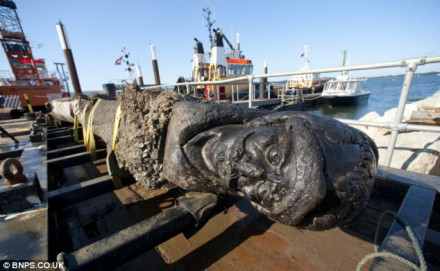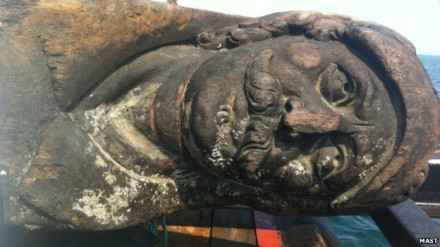History
Shipwreck
The so-called Swash Channel Wreck was discovered outside Poole Harbour in a sand and shingle bank that was struck by a dredger in 1990. In 2004, the site was first documented by Wessex Archaeology, during a geophysical survey in advance of dredging to deepen the approach to the harbour. Lying upside-down in approximately 6-9 metres of water with its longitudinal axis orientated north-east to south-west, this wreck from the early modern period was found to have survived in fantastic condition. An estimated 40% of the ship construction was found intact, prompting experts to hail the find as the most significant since the Mary Rose. English Heritage now administers the wreck and Bournemouth University are actively investigating the site.

Identification
Despite the wreck's fantastic condition, its identity still remains a mystery. There are several clues however. Tree-ring analysis of the wood materials of items recovered from the wreck established a felling date of 1628, and point to the Dutch-German border as the origin of the timber. These results are supported by analysis of the pottery and other objects found at the site, such as apothecary jars, iron cannons, wooden barrels, rigging elements, copper, pewter, bones, ceramic domestic material, leather shoes and musket balls. Based on the evidence, the wreck is thought to have been a Dutch armed merchantman that sank some time during the 1630s.
More clues lie in the constructional features of the ship. Looking at the structure itself and the size of the guns, the ship is thought to have measured over 40 meters in length. This would make it one of the larger ships around at the time. The wreck is also adorned with a number of wooden carvings, the oldest examples known in the UK and they could be amongst the oldest of their kind in the world. All this suggests that the vessel was a showcase of prestige and wealth, and likely belonged to a large conglomerate. Since the vessel's outer layer is a sacrificial coating of pine wood and tar, to be eaten by shipworm found in tropical waters, it can be assumed that the ship was involved in long distance trade.

The researchers first assumed that the wreck represents a Dutch East India Company (VOC) vessel. However, when the company's extensive archives were found to contain no mention of a ship wrecking in this area, attention turned to the Dutch West India Company (WIC). As this company's archives have largely been destroyed in the 19th century, and no identifying features have yet been discovered at the wreck site, concrete evidence for or against a link to the WIC remains absent. Even though the Swash Channel Wreck has not been identified, it still contains a wealth of information on the art of 17th century shipbuilding and life on board.

Description
Associated with: Dutch Republic.
Published archaeological documentation available.
Involved institutions: Bournemouth University, Wessex Archaeology, English Heritage.
Status
Partial recovery
The Swash Channel Wreck has survived in its excellent condition because it was soon buried by seabed sediments after it sank. However, when the wreck was revealed again by changes in the seabed after some 400 years, it not only attracted the attention of archaeologists but also that of wood-boring worms, and it became exposed to erosion processes. As a result, the Swash Channel Wreck has been rapidly disappearing ever since.
Despite stabilisation work on the wreck by archaeologists, which has included protecting it with various forms of coverings, it became clear that more drastic measures were necessary. With a Mary Rose-style recovery operation being prohibitively expensive, marine archaeologists from Bournemouth University led efforts to rescue parts of the ship deemed most at risk from degradation.
Thus in 2011, the forecastle, part of the upper structure of the ship, was raised and 12 metres of the bow followed the next year. The last major piece to be raised was the ship's spectacularly carved 2.5 ton rudder in 2013. Smaller artefacts brought up to the surface included more baroque carvings found on parts of the ship including the gunports, ceramic pieces, leather shoes, copper and pewter plates and cups and a bronze compass divider. Animal bones of sheep and cows that would have fed the crew were also recovered.

Status
Bournemouth University has analysed the finds and wreck parts. The part of the wreck that remains on the seabed is now covered in sediment and thereby preserved for future generations, thanks to the efforts of the archaeologists. It is one of the 46 sites in the English area of the UK Territorial Sea designated under The Protection of Wrecks Act 1973.


References
- Palma, P., D. Parham (2006).
Swash Channel Wreck; 2006 season report.
Centre for Marine and Coastal Archaeology. - Wooden carving of moustachioed warrior uncovered as wreckage of 400-year-old ship is pulled from the English Channel. .
- Wessex Archaeology.
Swash Channel Wreck. - Wessex Museums.
Swash Channel Wreck rudder.